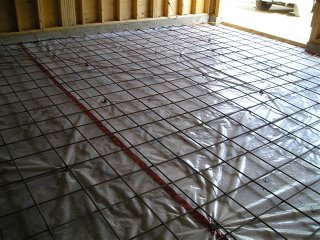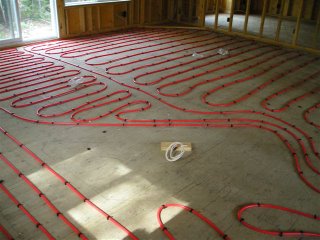I like to compare it to wandering in the desert, and stumbling over a tiny pebble. When we push away the sand, we find that this "pebble" is actually the tip of a gargantuan pyramid. After years of excavation, we find wondrous hieroglyphics, strange tunnels and secret passageways. Every time we think we are at the bottom stage, we find a stage below it. Finally, we think we are at the very bottom, and can see the doorway.
One day, some bright, enterprising physicist, perhaps inspired by this article, will complete the theory, open the doorway, and use the power of pure thought to determine if string theory is a theory of everything, anything, or nothing.
Only time will tell if Einstein was correct when he said, "But the creative principle resides in mathematics. In a certain sense, therefore, I hold it true that pure thought can grasp reality, as the ancients dreamed."
An Intermediate Polar Binary System. Credit & Copyright: Mark Garlick
Consider any physical system, made of anything at all- let us call it, The Thing. We require only that The Thing can be enclosed within a finite boundary, which we shall call the Screen(Figure39). We would like to know as much as possible about The Thing. But we cannot touch it directly-we are restrictied to making measurements of it on The Screen. We may send any kind of radiation we like through The Screen, and record what ever changes result The Screen. The Bekenstein bound says that there is a general limit to how many yes/no questions we can answer about The Thing by making observations through The Screen that surrounds it. The number must be less then one quarter the area of The Screen, in Planck units. What if we ask more questions? The principle tells us that either of two things must happen. Either the area of the screen will increase, as a result of doing an experiment that ask questions beyond the limit; or the experiments we do that go beyond the limit will erase or invalidate, the answers to some of the previous questions. At no time can we know more about The thing than the limit, imposed by the area of the Screen.
Page 171 and 172 0f, Three Roads to Quantum Gravity, by Lee Smolin
Now you have to understand something here that the views of those who push our perceptions have gone even further then this, in how we look at the universe. I am showing you work that was progressing from understanding and bringing together what was going on then in 2004, to show you indeed that such an progression has taken place.
I also point out where "Conformal Field Theory" has planted itself, as we look at the images of Bekenstein bound. Such determinations and the roads taken by Strominger point specifically to what we can measure and what we have yet to measure. This did nt relegate any theoretcial view to the "garbage dump" but allowed visionaries to see beyond the SUN/Earth relation in Lagrangian views.
ISCAP will demonstratively help you "adjust your view" in a cosmological re-adjustment that is necessary. Not only from Glast views that arose from some fantasy, but culminates today in the use of a scientific device(calorimeter) for such measures.
In Gamma Ray detection and the Early Universe I point the direction in how Glast in it's preparation has given us new views on how we look at the universe.
The Astrophysical Journal, in an article titled "Integral IBIS Extragalactic survey: Active Galactic Nuclei Selected at 20-100 keV", by L. Bassani et al., published on 10 January 2006 (vol. 636, pp L65-L68).
Meanwhile, the NASA team is now planning to extend his search for hidden black holes further out into the universe. "This is just the tip of the iceberg. In a few more months we will have a larger survey completed with the Swift mission. Our goal is to push this kind of observation deeper and deeper into the universe to see black hole activity at early epochs. That’s the next great challenge for X-ray and gamma-ray astronomers," concluded Beckmann.
Sun Earth Relation
Part of devloping this vision was to see in ways that the Grace satelitte allowed you to see. In what use "climate functions were happening" within the earth's atmosphere how it was being regarded. Time clock functiosn are necessary views, even within this context and such mapping allowed you to see th eearth as it had never been seen before.
No longer is it the surprize of the "first man to step out in space" to see such a blue marble and be aw struck by it's beauty. Now we have progressed in the same views that I allude too beyound what glast has done. Glast is your measure for now. Mine, and others, excell beyond this. As I show you why.
Dr. Mark Haskins:
On a wider class of complex manifolds - the so-called Calabi-Yau manifolds - there is also a natural notion of special Lagrangian geometry. Since the late 1980s these Calabi-Yau manifolds have played a prominent role in developments in High Energy Physics and String Theory. In the late 1990s it was realized that calibrated geometries play a fundamental role in the physical theory, and calibrated geometries have become synonymous with "Branes" and "Supersymmetry".
Now how abtract these views that I will show you to think indeed "theoretcial surmize exists for the potential to push perception." Then, I will give you a real image to ponder, as satellites now progress through this superhighway.

The second of five Lagrangian equilbrium points, approximately 1.5 million kilometers beyond Earth, where the gravitational forces of Earth and Sun balance to keep a satellite at a nearly fixed position relative to Earth.
In order to understand this sun/earth relation, you needed to see beyond what Glast had to impart to you. Yet, I do not say that it is irrelelavnt such experimental fashion to help us see even further. You understand this now?
So now, I'll show you what the universe looks like.
Diagram of the Lagrange Point gravitational forces associated with the Sun-Earth system. WMAP orbits around L2, which is about 1.5 million km from the Earth. Lagrange Points are positions in space where the gravitational forces of a two body system like the Sun and the Earth produce enhanced regions of attraction and repulsion. The forces at L2 tend to keep WMAP aligned on the Sun-Earth axis, but requires course correction to keep the spacecraft from moving toward or away from the Earth.
Now having this perspective in place, I am telling you what this does for perception, had I not carefully taken you through the roads to discovery. What the scale for gravity does for us in our estimation of what that universe actually looks like, when you put on glasses that change the very ideas of how we see.
While you may see refracting of the pencil in a glass of water, you may also see that the grvaiational relation is also apparent inhow we look at the universe?
If you do not think about the force carrier of the gravity then such extension to the standard model will only hold so much for you, while others in vision had been extended far beyond what you are accustom.
A Better Researcher, Not a Cynic...Yessss?:)
Sometimes there are wiser words then my own, to show what is "healthy and happy" with the research into quantum gravity? "A cynic" needs to wipe the spit from their chin, while recogizing what is really going on? We want a well balanced approach.
Approaches to the Quantum Theory of Gravity by the PI Institute
Two methods evolved in the theory of elementary particles to describe such quantized flux tubes. The one, called the loop method, studies them using the basic laws of electricity and magnetism, combined with quantum theory. The second, called string theory, postulates that the quantized flux tubes may be treated as fundamental in their own right, and the laws of electricity and magnetism derived from them.
Many theorists believe that these two points of view are actually equivalent—just different ways of studying the same thing from different points of view. The idea that they are the same is called duality, which here, as in other areas, signals that the same object is being studied with different ideas and methods.



